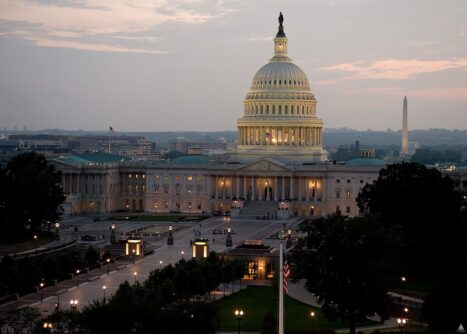And wondering about the red cocktail umbrella.
Inside Philanthropy editor David Callahan recently launched a new website, Blue Tent. It’s “grounded in a commitment to social inclusion, ecological sustainability, and global interdependence,” and intends to “build a Democratic Party that can translate [these values] into public policy as a true governing majority.”
The Blue Tent site points out that progressives and Democrats “need all the financial support they can get.” But this is a good time for nonprofits and candidates to find it. “Candidates are raising record sums from big and small donors alike. Nonprofit change agents are getting a boost as society reckons with various forms of systemic injustice and a growing ecological crisis. Philanthropies are backing progressive policy work, inclusive organizing, journalism, research, voter engagement—the list goes on.”
Indeed it does. Blue Tent features an initial compendium of some 200 Democrat-friendly foundations and grantmakers, including some of the largest and most prominent in the land: the Annie E. Casey Foundation, the Carnegie Corporation of New York, the Chan Zuckerberg Initiative, the Ford Foundation, the Hewlett Foundation, the James Irvine Foundation, the Joyce Foundation, the W. K. Kellogg Foundation, the MacArthur Foundation, and on and on. Another 75 names of the “rich and famous” appear on the list of “top progressive philanthropists.”
Envy
My first reaction to Blue Tent, I confess, was envy. Conservatives couldn’t launch a Red Tent if they wanted to, and not only because it might be confused with novelist Anita Diamant’s fan club. It would have to be more like a “red umbrella”—the sort that appears in tiki bar cocktails. There just wouldn’t be enough conservative entries to bother with, given the overwhelming predominance of progressives among nonprofits and foundations—much less enough to sustain a website demanding three editors, seven reporters, and four business and communication staffers.

And the situation isn’t getting any better for the right. Libertarian billionaire Charles Koch recently and forcefully delisted himself as a likely future funder for conservative causes, removing by far the largest player from “our” side of the field.
Even within the roll call of progressive donors, there is evidence of systemic, generational trouble for conservatism. Included among Blue Tent’s philanthropists is Lynde Bradley Uihlein, accompanied by this notation: “She may be related to some of the most prominent figures in conservative philanthropy, but this Wisconsin-based heiress has charted a different course with donations to progressive women's rights groups and Democratic political contributions.”
We Giving Review editors all worked for the foundation named for Uihlein’s grandfather and great-uncle, Milwaukee’s Lynde and Harry Bradley Foundation, long held to be a kingpin of conservative philanthropy. As a recent New York Times article on the socialist heirs of billionaire capitalists reminds us, the leftward drift of sons and daughters of wealthy conservatives is widely understood to be an ineluctable force of political nature.
Alarm
While feeling sorry for myself, I also began to reflect on the larger state of affairs illuminated by the launch of Blue Tent, which promises to track “multiple funder types—501(c)(3), 501(c)4, 527, and donations to party committees and candidates themselves.” When I first came to philanthropy as a program officer for the Bradley Foundation in 1992, such a nonchalant and indiscriminate lumping of foundations and nonprofits into a list of manifestly partisan political institutions would have set off all sorts of ethical and legal alarms.
In large part, that’s because those providing legal counsel to Bradley were top-notch. They were led by a nationally recognized expert in the law of tax-exempt organizations, and their advice reflected deep knowledge of and a rigid respect for the line between philanthropy and politics.
The standard grant contract contained language, mirroring Treasury Department regulations, saying things like “no portion of any grant by grantor shall be used to carry on propaganda, or otherwise to attempt to influence legislation, including any referendum, or to participate or intervene in any political campaign on behalf of or in opposition to any candidate for public office.”
If the grantee proposed to carry out “nonpartisan analysis, study or research,” it was to be done “in strict compliance with all U.S. Department of the Treasury and U.S. Internal Revenue Service regulations.” That meant that grantees could “advocate a viewpoint, but ... must reflect objectivity, a full and fair exposition of the facts, and lack of unsupported opinion,” and “not encourage the recipient to take action with respect to legislation (including any referendum) or be directed solely to persons who are interested only in one side of an issue.” Finally, “no substantial part” of the grantee’s activities were to be used “to influence legislation (including any referendum) within the meaning of IRC Section 501(c)(3).”
The foundation’s vice president for program, as well as the grantee, were obliged to sign the contract, binding them to its conditions. In addition, we were cautioned against trafficking in grant proposals containing words—like “victory,” “fight,” “win,” “defeat,” and so forth—that carried the slightest whiff of political campaigning. In order to internalize these rules, I naturally tried to imagine how each proposal would appear to a suspicious IRS agent, rummaging through our files.
Our counsel would not have been amused to find a foundation client of theirs prominently listed on a hypothetical Red Umbrella website, dedicated to building the Republican Party into “a true governing majority.” Nor would the overwhelming majority of our local grantees in the inner city, who were far more likely to find themselves under the blue tent.
Innocence
Those were certainly more innocent times. Just how innocent, I came to realize after returning to Washington in 2001, in order to run the Hudson Institute’s Bradley Center for Philanthropy and Civic Renewal. Shortly thereafter, I attended a conference sponsored by one of the major campaign finance reform organizations.
One session featured a chart of the full variety of philanthropic and nonprofit institutions, as well as more explicitly political entities, arrayed as they would be viewed by a potential wealthy donor, looking for the savviest electoral investment. In this scheme, the only question was, how effectively can each kind of organization be harnessed to achieve partisan purposes? From the donor’s view, legal distinctions like those we had tried to observe as Bradley program officers were just incidentals, easily manipulated or ignored by the wealthy and powerful.
The late Rick Cohen, then executive director of the National Committee for Responsive Philanthropy, was at the same conference, and we had the same reaction to this presentation: had we really arrived at the point where foundations and nonprofits were simply to be considered handy devices, along with PACs and campaign committees, for the wealthy to achieve their own personal ends?
However ideologically different Rick and I were, we shared the conviction that the nonprofit sector was the beating heart of American democracy—the place where everyday citizens could come together, thrash out differences, and form the community bonds necessary to solve their own problems and govern their own lives. The laws and regulations setting nonprofits apart and bestowing indirect public support through charitable deductions were meant to enable and honor this.
And yet here civil society institutions were being treated as if they were mere playthings of wealthy partisans. They were useful only insofar as they could be wrestled into strategic alignment with the more important political players downstream—although tax incentives compensated somewhat for the legal fees required to circumvent their annoying legal limitations.
The conference’s sponsoring organization was staunchly pro-campaign finance reform, but this chart suggested just how daunting it would be to limit, control, or even monitor spending for political campaigns. Even as the rules were tightened on explicitly electoral expenditures, the vast sums of money seeking ways to influence political outcomes would simply carve new channels around the rules, overflowing the border between politics and charity, turning modest and circumspect charities into swaggering partisan behemoths.
Today
And so we arrive at today’s Blue Tent. Now it’s no longer suspect, or even noteworthy, to treat nonprofits and foundations as anything other than useful tools to “build a Democratic Party that can translate [progressive values] into public policy as a true governing majority.”
But here’s the thing. As naïve as they may seem, and as casually as they are today violated, the legal limitations for foundations and nonprofits as explained to us by legal counsel are still pretty much on the books. Yet the public, along with most members of Congress, are largely unaware that vast swaths of charity are being used for partisan electoral purposes.
Perhaps one of the unintended consequences of Blue Tent will be to open the eyes of the public and Congress to the politicization of our nonprofit sector, and prompt us to seek ways to restore the boundary between politics and charity.







And here I thought all those blue tents in Democrat-controlled cities was a symptom of a critical problem. I should have known it was intentional. My mistake.